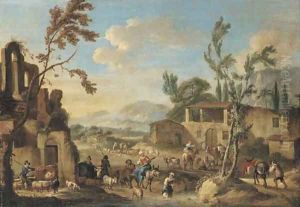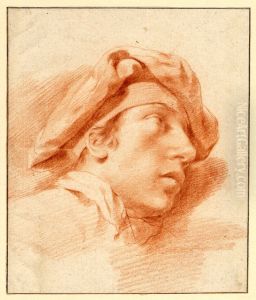Dirck Helmbreker Paintings
Dirck Helmbreker, also known as Dirck (Theodorus) Helmigh van Nijmegen, was a Dutch painter born in Haarlem in 1633. He is primarily recognized for his Italianate landscapes and genre scenes that were influenced by the Roman Campagna's serene beauty and the works of Claude Lorrain, a French painter who also specialized in idealized landscapes. Helmbreker's style is characteristic of the Dutch Italianates, a group of 17th-century Dutch artists who lived and worked in Italy and whose work was shaped by the Italian environment and the classical tradition.
Helmbreker moved to Rome at a young age, as did many Northern European artists seeking to study Italian art and antiquities first-hand. Rome during the 17th century was a vibrant center for artists, and Helmbreker became part of the Bentvueghels, a society of mostly Dutch and Flemish artists living in Rome. The members of this group, known for their boisterous behavior and the adoption of nicknames, called Helmbreker 'Dirk van Haarlem.' His works from this period show a strong influence from the Roman countryside, and he often depicted everyday life with peasants and shepherds amidst ancient ruins, combining a sense of romanticism with realistic detail.
Helmbreker returned to Haarlem later in his career, where he continued to paint and influence other artists with his Italianate style. His work was appreciated for its warm colors, adept handling of light, and harmonious compositions, which often included architectural elements and expansive skies. Unfortunately, Helmbreker's works are not as well-known today, and his contribution to the Dutch Golden Age of painting is often overshadowed by his more famous contemporaries.
Dirck Helmbreker died in 1696 in Haarlem. Despite the relative obscurity of his name nowadays, his paintings can still be found in the collections of various art museums, offering a window into the world of the Dutch Italianates and the enduring allure of the Italian landscape in the Dutch artistic imagination.

